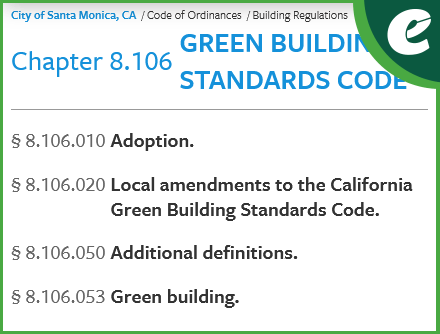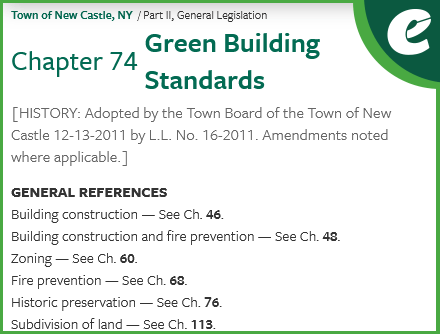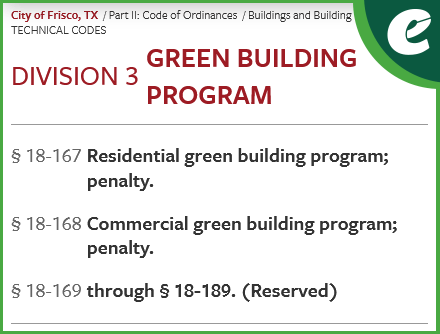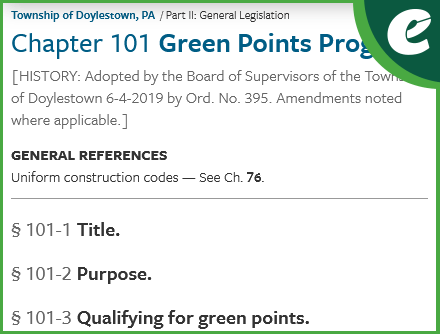To meet the challenges of climate change, municipalities across the nation are setting goals for greater sustainability, reducing gashouse emissions, being more energy efficient, and creating a healthier, resilient environment for their residents. Adopting green building standards and providing an enforceable policy framework is a big step toward achieving these goals.
What are Green Building Codes?
Generally speaking, building standards exist to ensure safe and efficient design and construction. The standards provide “a minimum requirement for various project phases, typologies and design components, depending on the type of building standard.”
A green building standard is meant to guide architects, engineers, contractors, and developers in an effort to ensure that building practices address sustainable tactics such as water, energy, and resource conservation. The goal of implementing green standards, according to the U.S. Green Building Council, is to contribute to a less environmentally-compromised world by reducing toxins and harmful emissions and achieving a healthier living situation for those using the buildings.
View sample green building standards legislation >
What are the benefits of Green Building Standards?
Potential benefits of green building standards can include improving the environment, cost-efficiency, economic, and health:
- Water – Green building can not only decrease water waste, but may also contribute to enrich water reserves, preserve natural resources, defend biodiversity and enhance air and water quality.
- Carbon footprint – Green building also reduces your carbon footprint by producing less waste and decreasing the amount of toxic gases set free into the air.
- Cost-efficiency – Properties that are green built, may require lower maintenance costs and be more cost-effective to operate as they are built from sustainable components which in turn adds value to the property.
- Health – Green building strategies aim at enhancing the life of building occupants through cleaner indoor air as well as reducing liability for owners of buildings from air contamination problems.
- Energy – Making a building more energy-efficient and using renewable energy sources can reduce greenhouse gas emissions and have a positive impact on the building’s surrounding environment.
Green buildings provide better comfort, productivity, and overall well-being to the occupants and can save costs for building owners in the long run. As high-performance structures, green buildings have proven to provide a high return on the investment they require.
Going green at the local level
Local governments that have addressed green building principles have employed various means to achieve their goals. Methods have included land use regulation, establishing green design standards, and offering incentives such as fee waivers, property tax abatements, green loan funding, and permit fee reductions.
Further, to encourage green building, the Inflation Reduction Act of 2022 included unprecedented investments, including rebates and incentives to ensure that buildings are highly efficient and resilient. And it applies not only to new construction but also existing structures. Some of its most important provisions are actually aimed at providing pathways for existing buildings to assess tax deductions for retrofits.
Useful green building standards legislation resources
If your community is interested in establishing green building standards, the International Code Council, the American Institute of Architects (AIA), the American Society of Heating, Refrigerating and Air-Conditioning Engineers (ASHRAE), the US Green Building Council (USGBC) and the Illuminating Engineering Society (IES) have developed the International Green Construction Code (IgCC). The IgCC provides the design and construction industry “with the single, most effective way to deliver integrated energy conservation, water efficiency, site and material sustainability, land use, and indoor environmental quality.”
Additionally, local governments wanting to legislate or update ordinances relating to green building can find useful examples from General Code client communities in our eCode360 Library:
Updating your municipal code is vitally important
Did you know you can set up a regular update schedule, so you don’t have to worry about compiling materials or taking up time and resources of your staff to do the updates yourself? As your municipality passes legislation, send it to General Code and we’ll take care of the rest. It’s just that simple!
For tips that will allow us to process your code updates most efficiently, click here.
Questions about updating your code?
Our Client Care team is available to explain the options and benefits of scheduled code updates or any other code-related questions you might have.
Sources:
- Green building Standards and Certifications: Building The Best with Green
- A GUIDE TO GREEN BUILDING CODES AND STANDARDS
- Top Green Building Standards: A Guide For Green Building Professionals
- U.S. Green Building Council
- Top 5 Benefits of Green Building
- LEED Locally: How Local Governments Can Effectively Mandate Green Building Standards
- Renewable Energy
- Greenhouse Gas Emissions (Wikipedia)
- Inflation Reduction Act of 2022
- How Local Governments Are Transforming Green Building Policies — and How to Prepare
- White House Unveils a New Climate Fix: Building Codes and Energy Retrofits
- Why updated building codes have cities seeing green
- Green Building Standards
- eCode360® online code library






